Published Journal Articles
2020
Covalent immobilization of Aspergillus niger amyloglucosidase (ANAG) with ethylenediamine-functionalized and glutaraldehyde-activated active carbon (EFGAAC) obtained from sesame seed shell
2020-01
International Journal of Biological Macromolecules (Issue : 01418130) (Volume : 142)
This study was aimed the covalently immobilization of Aspergillus niger amyloglucosidase (ANAG) onto
activated carbon (AC) obtained from sesame seed shell. AC was firstly functionalized with ethylenediamine,
and after then activated with glutaraldehyde. 99.80% immobilization yield and 99.83% activity
yield were obtained as the result of optimization of immobilization conditions (pH and molarity of immobilization
buffer, AC amount, and reaction time). The optimum pH (5.5) and the optimum temperature
range (55–60 C) for ANAG were not affected by immobilization. After immobilization, Vmax value
decreased from 1464.1 lmol D-glucose/L.min to 1342.3 lmol D-glucose/L.min, while Km value decreased
from 116.3 g maltodextrin/L to 109.9 g maltodextrin/L. The immobilized enzyme retained 99.30% and
98.30% of its initial activity, respectively after twenty repeated uses and after twenty days of storage
in 5 mL sodium phosphate buffer (0.1 M, pH 5.5) at +4 C in a refrigerator. Finally, glucose syrup was produced
from maltodextrin solution having 1% (w/v) concentration by using the immobilized ANAG.
Maltodextrin was completely converted to glucose after four hours. Consequently, it can be said that
the immobilized ANAG obtained in this study can be used in the industrial production of glucose syrup.
2018
Preparation and Characterization of Activated Carbon from Sesame Seed Shells by Microwave and Conventional Heating with Zinc Chloride Activation
2018-05
Analytical Letters (Issue : 17) (Volume : 51)
The preparation of activated carbon from sesame shells as raw
precursor was investigated in the study by sequentially applying
microwave and conventional heating methods assisted by zinc
chloride activation. The optimizisation of experimental parameters
including microwave power, microwave treatment time, conventional
activation time, conventional activation temperature and zinc chloride
concentration ratio for the microwave and conventional heating
method was performed. The characterization of the prepared
activated carbon was done by thermogravimetric and differential
thermal measurements, infrared spectroscopy, scanning electron
microscopy and specific surface area analyses. The maximum surface
area of 1254 m2/g for the prepared activated carbon was obtained at a
microwave power of 750 W, a microwave treatment time of 20 min, an
activation time of 45 min, an activation temperature of 500°C and zinc
chloride concentration ratio of 1:1. Methylene blue and iodine
adsorption capacities for the prepared activated carbon were 103
and 1199 mg/g, respectively.
Back
